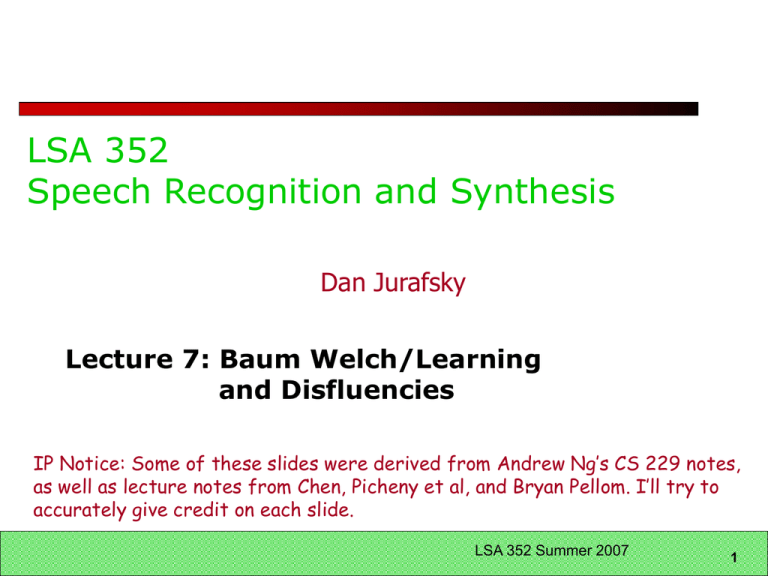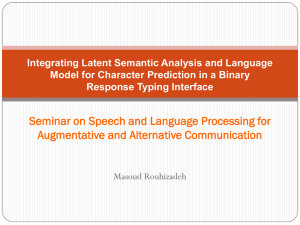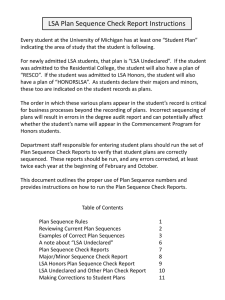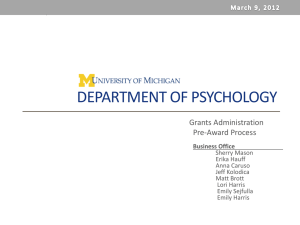Lec 7 - The Stanford NLP
advertisement

LSA 352
Speech Recognition and Synthesis
Dan Jurafsky
Lecture 7: Baum Welch/Learning
and Disfluencies
IP Notice: Some of these slides were derived from Andrew Ng’s CS 229 notes,
as well as lecture notes from Chen, Picheny et al, and Bryan Pellom. I’ll try to
accurately give credit on each slide.
LSA 352 Summer 2007
1
Outline for Today
Learning
EM for HMMs (the “Baum-Welch Algorithm”)
Embedded Training
Training mixture gaussians
Disfluencies
LSA 352 Summer 2007
2
The Learning Problem
Baum-Welch = Forward-Backward Algorithm
(Baum 1972)
Is a special case of the EM or ExpectationMaximization algorithm (Dempster, Laird, Rubin)
The algorithm will let us train the transition
probabilities A= {aij} and the emission probabilities
B={bi(ot)} of the HMM
LSA 352 Summer 2007
3
Input to Baum-Welch
O
Q
unlabeled sequence of observations
vocabulary of hidden states
For ice-cream task
O = {1,3,2.,,,.}
Q = {H,C}
LSA 352 Summer 2007
4
Starting out with Observable
Markov Models
How to train?
Run the model on the observation sequence O.
Since it’s not hidden, we know which states we went
through, hence which transitions and observations
were used.
Given that information, training:
B = {bk(ot)}: Since every state can only generate
one observation symbol, observation likelihoods B
are all 1.0
A = {aij}:
C(i j)
aij
C(i q)
q Q
LSA 352 Summer 2007
5
Extending Intuition to HMMs
For HMM, cannot compute these counts directly from
observed sequences
Baum-Welch intuitions:
Iteratively estimate the counts.
– Start with an estimate for aij and bk, iteratively improve
the estimates
Get estimated probabilities by:
– computing the forward probability for an observation
– dividing that probability mass among all the different
paths that contributed to this forward probability
LSA 352 Summer 2007
6
The Backward algorithm
We define the backward probability as
follows:
t (i) P(ot 1,ot 2 ,...oT ,| qt i,)
This is the probability of generating partial
observations Ot+1T from time t+1 to the end, given
that the HMM is in state i at time t and of course
given .
LSA 352 Summer 2007
7
The Backward algorithm
We compute backward prob by induction:
LSA 352 Summer 2007
8
Inductive step of the backward algorithm
(figure inspired by Rabiner and Juang)
Computation of t(i) by weighted sum of all successive values t+1
LSA 352 Summer 2007
9
Intuition for re-estimation of aij
We will estimate ^aij via this intuition:
aˆ ij
expected number of transitions from state i to state j
expected number of transitions from state i
Numerator intuition:
Assume we had some estimate of probability that a
given transition i->j was taken at time t in
observation sequence.
If we knew this probability for each time t, we could
sum over all t to get expected value (count) for i->j.
LSA 352 Summer 2007
10
Re-estimation of aij
Let t be the probability of being in state i at time t
and state j at time t+1, given O1..T and model :
t (i, j) P(qt i,qt 1 j | O, )
We can compute from not-quite-, which is:
not _ quite _ t (i, j) P(qt i,qt 1 j,O | )
LSA 352 Summer 2007
11
Computing not-quite-
T he four components of
P(qt i,qt 1 j,) | ) : , ,aij and b j (ot )
LSA 352 Summer 2007
12
From not-quite- to
We want:
t (i, j) P(qt i,qt 1 j | O, )
We’ve got:
not _ quite _ t (i, j) P(qt i,qt 1 j,O | )
Which we compute as follows:
LSA 352 Summer 2007
13
From not-quite- to
We want:
t (i, j) P(qt i,qt 1 j | O, )
We’ve got:
not _ quite _ t (i, j) P(qt i,qt 1 j,O | )
Since:
not _ quite _ t (i, j)
t (i, j)
P(O | )
We need:
LSA 352 Summer 2007
14
From not-quite- to
not _ quite _ t (i, j)
t (i, j)
P(O | )
LSA 352 Summer 2007
15
From to aij
aˆ ij
expected number of transitions from state i to state j
expected number of transitions from state i
The expected number of transitions from state i to
state j is the sum over all t of
The total expected number of transitions out of state i
is the sum over all transitions out of state i
Final formula for reestimated aij
LSA 352 Summer 2007
16
Re-estimating the observation
likelihood b
expected number of times in state j and observing symbol
bˆ j (v k )
expected number of times in state j
vk
We’ll need to know the probability of being in state j at time t:
LSA 352 Summer 2007
17
Computing gamma
LSA 352 Summer 2007
18
Summary
The ratio between the
expected number of
transitions from state i to j
and the expected number of
all transitions from state i
The ratio between the
expected number of times
the observation data emitted
from state j is vk, and the
expected number of times
any observation is emitted
from state j
LSA 352 Summer 2007
19
Summary: Forward-Backward
Algorithm
1)
2)
3)
4)
5)
Intialize =(A,B)
Compute , ,
Estimate new ’=(A,B)
Replace with ’
If not converged go to 2
LSA 352 Summer 2007
20
The Learning Problem: Caveats
Network structure of HMM is always created by hand
no algorithm for double-induction of optimal structure
and probabilities has been able to beat simple handbuilt structures.
Always Bakis network = links go forward in time
Subcase of Bakis net: beads-on-string net:
Baum-Welch only guaranteed to return local max,
rather than global optimum
LSA 352 Summer 2007
21
Complete Embedded Training
Setting all the parameters in an ASR system
Given:
training set: wavefiles & word transcripts for each
sentence
Hand-built HMM lexicon
Uses:
Baum-Welch algorithm
We’ll return to this after we’ve introduced GMMs
LSA 352 Summer 2007
22
Baum-Welch for Mixture Models
By analogy with earlier, let’s define the probability of being in state j
at time t with the kth mixture component accounting for ot:
N
Now,
tm ( j)
jm
( j)aijc jmb jm (ot ) j (t)
i1
T
t1
F (T)
T
tm
( j)ot
c jm
t1
T M
t1 k1
tk
( j)
T
tm
( j)
jm
t1
T M
t1 k1
tk
( j)
tm
( j)(ot j )(ot j )T
t1
T
M
tm
( j)
t1 k1
LSA 352 Summer 2007
23
How to train mixtures?
•
•
•
1)
2)
3)
4)
Choose M (often 16; or can tune M dependent on
amount of training observations)
Then can do various splitting or clustering
algorithms
One simple method for “splitting”:
Compute global mean and global variance
Split into two Gaussians, with means
(sometimes is 0.2)
Run Forward-Backward to retrain
Go to 2 until we have 16 mixtures
LSA 352 Summer 2007
24
Embedded Training
Components of a speech recognizer:
Feature extraction: not statistical
Language model: word transition probabilities,
trained on some other corpus
Acoustic model:
– Pronunciation lexicon: the HMM structure for each word,
built by hand
– Observation likelihoods bj(ot)
– Transition probabilities aij
LSA 352 Summer 2007
25
Embedded training of acoustic
model
If we had hand-segmented and hand-labeled training data
With word and phone boundaries
We could just compute the
B: means and variances of all our triphone gaussians
A: transition probabilities
And we’d be done!
But we don’t have word and phone boundaries, nor phone
labeling
LSA 352 Summer 2007
26
Embedded training
Instead:
We’ll train each phone HMM embedded in an entire
sentence
We’ll do word/phone segmentation and alignment
automatically as part of training process
LSA 352 Summer 2007
27
Embedded Training
LSA 352 Summer 2007
28
Initialization: “Flat start”
Transition probabilities:
set to zero any that you want to be “structurally
zero”
– The probability computation includes previous value of
aij, so if it’s zero it will never change
Set the rest to identical values
Likelihoods:
initialize and of each state to global mean and
variance of all training data
LSA 352 Summer 2007
29
Embedded Training
Now we have estimates for A and B
So we just run the EM algorithm
During each iteration, we compute forward and
backward probabilities
Use them to re-estimate A and B
Run EM til converge
LSA 352 Summer 2007
30
Viterbi training
Baum-Welch training says:
We need to know what state we were in, to accumulate counts of a
given output symbol ot
We’ll compute I(t), the probability of being in state i at time t, by
using forward-backward to sum over all possible paths that might
have been in state i and output ot.
Viterbi training says:
Instead of summing over all possible paths, just take the single
most likely path
Use the Viterbi algorithm to compute this “Viterbi” path
Via “forced alignment”
LSA 352 Summer 2007
31
Forced Alignment
Computing the “Viterbi path” over the training data is
called “forced alignment”
Because we know which word string to assign to each
observation sequence.
We just don’t know the state sequence.
So we use aij to constrain the path to go through the
correct words
And otherwise do normal Viterbi
Result: state sequence!
LSA 352 Summer 2007
32
Viterbi training equations
Viterbi
n ij
aˆ ij
ni
Baum-Welch
For all pairs of emitting states,
1 <= i, j <= N
n
(s.t.o
v
)
j
t
k
bˆ j (v k )
nj
Where nij is number of frames with transition from i to j in best path
And nj is number of frames where state j is occupied
LSA 352 Summer 2007
33
Viterbi Training
Much faster than Baum-Welch
But doesn’t work quite as well
But the tradeoff is often worth it.
LSA 352 Summer 2007
34
Viterbi training (II)
Equations for non-mixture Gaussians
1 T
i ot s.t. qt i
N i t1
T
1
2
i
(ot i ) s.t. qt i
N i t 1
2
Viterbi training for mixture Gaussians is more
complex, generally just assign each observation to 1
mixture
LSA 352 Summer 2007
35
Log domain
In practice, do all computation in log domain
Avoids underflow
Instead of multiplying lots of very small probabilities, we
add numbers that are not so small.
Single multivariate Gaussian (diagonal ) compute:
In log space:
LSA 352 Summer 2007
36
Log domain
Repeating:
With some rearrangement of terms
Where:
Note that this looks like a weighted Mahalanobis distance!!!
Also may justify why we these aren’t really probabilities (point
estimates); these are really just distances.
LSA 352 Summer 2007
37
State Tying:
Young, Odell, Woodland 1994
The steps in creating CD
phones.
Start with monophone, do EM
training
Then clone Gaussians into
triphones
Then build decision tree and
cluster Gaussians
Then clone and train mixtures
(GMMs
LSA 352 Summer 2007
38
Summary: Acoustic Modeling for
LVCSR.
Increasingly sophisticated models
For each state:
Gaussians
Multivariate Gaussians
Mixtures of Multivariate Gaussians
Where a state is progressively:
CI Phone
CI Subphone (3ish per phone)
CD phone (=triphones)
State-tying of CD phone
Forward-Backward Training
Viterbi training
LSA 352 Summer 2007
39
Outline
Disfluencies
Characteristics of disfluences
Detecting disfluencies
MDE bakeoff
Fragments
LSA 352 Summer 2007
40
Disfluencies
LSA 352 Summer 2007
41
Disfluencies:
standard terminology (Levelt)
Reparandum: thing repaired
Interruption point (IP): where speaker breaks off
Editing phase (edit terms): uh, I mean, you know
Repair: fluent continuation
LSA 352 Summer 2007
42
Why disfluencies?
Need to clean them up to get understanding
Does American airlines offer any one-way flights [uh] oneway fares for 160 dollars?
Delta leaving Boston seventeen twenty one arriving Fort
Worth twenty two twenty one forty
Might help in language modeling
Disfluencies might occur at particular positions (boundaries
of clauses, phrases)
Annotating them helps readability
Disfluencies cause errors in nearby words
LSA 352 Summer 2007
43
Counts (from Shriberg, Heeman)
Sentence disfluency rate
ATIS: 6% of sentences disfluent (10% long sentences)
Levelt human dialogs: 34% of sentences disfluent
Swbd: ~50% of multiword sentences disfluent
TRAINS: 10% of words are in reparandum or editing phrase
Word disfluency rate
SWBD:
ATIS:
AMEX
6%
0.4%
13%
– (human-human air travel)
LSA 352 Summer 2007
44
Prosodic characteristics of
disfluencies
Nakatani and Hirschberg 1994
Fragments are good cues to disfluencies
Prosody:
Pause duration is shorter in disfluent silence than fluent
silence
F0 increases from end of reparandum to beginning of
repair, but only minor change
Repair interval offsets have minor prosodic phrase
boundary, even in middle of NP:
– Show me all n- | round-trip flights | from Pittsburgh | to
Atlanta
LSA 352 Summer 2007
45
Syntactic Characteristics of
Disfluencies
Hindle (1983)
The repair often has same structure as reparandum
Both are Noun Phrases (NPs) in this example:
So if could automatically find IP, could find and correct
reparandum!
LSA 352 Summer 2007
46
Disfluencies and LM
Clark and Fox Tree
Looked at “um” and “uh”
“uh” includes “er” (“er” is just British non-rhotic
dialect spelling for “uh”)
Different meanings
Uh: used to announce minor delays
– Preceded and followed by shorter pauses
Um: used to announce major delays
– Preceded and followed by longer pauses
LSA 352 Summer 2007
47
Um versus uh: delays
(Clark and Fox Tree)
LSA 352 Summer 2007
48
Utterance Planning
The more difficulty speakers have in planning, the more delays
Consider 3 locations:
I: before intonation phrase: hardest
II: after first word of intonation phrase: easier
III: later: easiest
And then uh somebody said, . [I] but um -- [II] don’t you think
there’s evidence of this, in the twelfth - [III] and thirteenth
centuries?
LSA 352 Summer 2007
49
Delays at different points in phrase
LSA 352 Summer 2007
50
Disfluencies in language modeling
Should we “clean up” disfluencies before training LM
(i.e. skip over disfluencies?)
Filled pauses
– Does United offer any [uh] one-way fares?
Repetitions
– What what are the fares?
Deletions
– Fly to Boston from Boston
Fragments (we’ll come back to these)
– I want fl- flights to Boston.
LSA 352 Summer 2007
51
Does deleting disfluencies
improve LM perplexity?
Stolcke and Shriberg (1996)
Build two LMs
Raw
Removing disfluencies
See which has a higher perplexity on the data.
Filled Pause
Repetition
Deletion
LSA 352 Summer 2007
52
Change in Perplexity when Filled
Pauses (FP) are removed
LM Perplexity goes up at following word:
Removing filled pauses makes LM worse!!
I.e., filled pauses seem to help to predict next word.
Why would that be?
Stolcke and Shriberg 1996
LSA 352 Summer 2007
53
Filled pauses tend to occur at
clause boundaries
Word before FP is end of previous clause; word after
is start of new clause;
Best not to delete FP
Some of the different things we’re doing [uh] there’s
not time to do it all
“there’s” is very likely to start a sentence
So P(there’s|uh) is better estimate than
P(there’s|doing)
LSA 352 Summer 2007
54
Suppose we just delete medial FPs
Experiment 2:
Parts of SWBD hand-annotated for clauses
Build FP-model by deleting only medial FPs
Now prediction of post-FP word (perplexity) improves
greatly!
Siu and Ostendorf found same with “you know”
LSA 352 Summer 2007
55
What about REP and DEL
S+S built a model with “cleaned-up” REP and DEL
Slightly lower perplexity
But exact same word error rate (49.5%)
Why?
Rare: only 2 words per 100
Doesn’t help because adjacent words are
misrecognized anyhow!
LSA 352 Summer 2007
56
Stolcke and Shriberg conclusions wrt
LM and disfluencies
Disfluency modeling purely in the LM probably won’t
vastly improve WER
But
Disfluencies should be considered jointly with
sentence segmentation task
Need to do better at recognizing disfluent words
themselves
Need acoustic and prosodic features
LSA 352 Summer 2007
57
WER reductions from modeling
disfluencies+background events
Rose and Riccardi (1999)
LSA 352 Summer 2007
58
HMIHY Background events
Out of 16,159 utterances:
Filled Pauses
7189
Word Fragments
1265
Hesitations
792
Laughter
163
Lipsmack
2171
Breath
8048
Non-Speech Noise
8834
Background Speech
3585
Operater Utt.
5112
Echoed Prompt
5353
LSA 352 Summer 2007
59
Phrase-based LM
“I would like to make a collect call”
“a [wfrag]”
<dig3> [brth] <dig3>
“[brth] and I”
LSA 352 Summer 2007
60
Rose and Riccardi (1999)
Modeling “LBEs” does help in WER
ASR Word Accuracy
System Configuration
Test Corpora
HMM
LM
Greeting
(HMIHY)
Card Number
Baseline
Baseline
58.7
87.7
LBE
Baseline
60.8
88.1
LBE
LBE
60.8
89.8
LSA 352 Summer 2007
61
More on location of FPs
Peters: Medical dictation task
Monologue rather than dialogue
In this data, FPs occurred INSIDE clauses
Trigram PP after FP: 367
Trigram PP after word: 51
Stolcke and Shriberg (1996b)
wk FP wk+1: looked at P(wk+1|wk)
Transition probabilities lower for these transitions than
normal ones
Conclusion:
People use FPs when they are planning difficult things, so
following words likely to be unexpected/rare/difficult
LSA 352 Summer 2007
62
Detection of disfluencies
Nakatani and Hirschberg
Decision tree at wi-wj boundary
pause duration
Word fragments
Filled pause
Energy peak within wi
Amplitude difference between wi and wj
F0 of wi
F0 differences
Whether wi accented
Results:
78% recall/89.2% precision
LSA 352 Summer 2007
63
Detection/Correction
Bear, Dowding, Shriberg (1992)
System 1:
Hand-written pattern matching rules to find repairs
–
–
–
–
Look for identical sequences of words
Look for syntactic anomalies (“a the”, “to from”)
62% precision, 76% recall
Rate of accurately correcting: 57%
LSA 352 Summer 2007
64
Using Natural Language
Constraints
Gemini natural language system
Based on Core Language Engine
Full syntax and semantics for ATIS
Coverage of whole corpus:
70% syntax
50% semantics
LSA 352 Summer 2007
65
Using Natural Language
Constraints
Gemini natural language system
Run pattern matcher
For each sentence it returned
Remove fragment sentences
Leaving 179 repairs, 176 false positives
Parse each sentence
– If succeed: mark as false positive
– If fail:
run pattern matcher, make corrections
Parse again
If succeeds, mark as repair
If fails, mark no opinion
LSA 352 Summer 2007
66
NL Constraints
Syntax Only
Precision: 96%
Syntax and Semantics
Correction: 70%
LSA 352 Summer 2007
67
Recent work: EARS Metadata
Evaluation (MDE)
A recent multiyear DARPA bakeoff
Sentence-like Unit (SU) detection:
find end points of SU
Detect subtype (question, statement, backchannel)
Edit word detection:
Find all words in reparandum (words that will be removed)
Filler word detection
Filled pauses (uh, um)
Discourse markers (you know, like, so)
Editing terms (I mean)
Interruption point detection
LSA
Summer 2007
Liu
et 352
al 2003
68
Kinds of disfluencies
Repetitions
I * I like it
Revisions
We * I like it
Restarts (false starts)
It’s also * I like it
LSA 352 Summer 2007
69
MDE transcription
Conventions:
./ for statement SU boundaries,
<> for fillers,
[] for edit words,
* for IP (interruption point) inside edits
And <uh> <you know> wash your clothes wherever
you are ./ and [ you ] * you really get used to the
outdoors ./
LSA 352 Summer 2007
70
MDE Labeled Corpora
CTS
BN
Training set (words)
484K
182K
Test set (words)
35K
45K
STT WER (%)
14.9
11.7
SU %
13.6
8.1
Edit word %
7.4
1.8
Filler word %
6.8
1.8
LSA 352 Summer 2007
71
MDE Algorithms
Use both text and prosodic features
At each interword boundary
Extract Prosodic features (pause length, durations,
pitch contours, energy contours)
Use N-gram Language model
Combine via HMM, Maxent, CRF, or other classifier
LSA 352 Summer 2007
72
State of the art: SU detection
2 stage
Decision tree plus N-gram LM to decide boundary
Second maxent classifier to decide subtype
Current error rates:
Finding boundaries
– 40-60% using ASR
– 26-47% using transcripts
LSA 352 Summer 2007
73
State of the art: Edit word
detection
Multi-stage model
– HMM combining LM and decision tree finds IP
– Heuristics rules find onset of reparandum
– Separate repetition detector for repeated words
One-stage model
CRF jointly finds edit region and IP
BIO tagging (each word has tag whether is beginning of
edit, inside edit, outside edit)
Error rates:
43-50% using transcripts
80-90% using ASR
LSA 352 Summer 2007
74
Using only lexical cues
3-way classification for each word
Edit, filler, fluent
Using TBL
Templates: Change
–
–
–
–
Word X from L1 to L2
Word sequence X Y to L1
Left side of simple repeat to L1
Word with POS X from L1 to L2 if followed by word with
POS Y
LSA 352 Summer 2007
75
Rules learned
Label
Label
Label
Label
Label
Label
all fluent filled pauses as fillers
the left side of a simple repeat as an edit
“you know” as fillers
fluent well’s as filler
fluent fragments as edits
“I mean” as a filler
LSA 352 Summer 2007
76
Error rates using only lexical
cues
CTS, using transcripts
Edits: 68%
Fillers: 18.1%
Broadcast News, using transcripts
Edits 45%
Fillers 6.5%
Using speech:
Broadcast news filler detection from 6.5% error to 57.2%
Other systems (using prosody) better on CTS, not on Broadcast
News
LSA 352 Summer 2007
77
Conclusions: Lexical Cues Only
Can do pretty well with only words
(As long as the words are correct)
Much harder to do fillers and fragments from ASR
output, since recognition of these is bad
LSA 352 Summer 2007
78
Fragments
Incomplete or cut-off words:
Leaving at seven fif- eight thirty
uh, I, I d-, don't feel comfortable
You know the fam-, well, the families
I need to know, uh, how- how do you feel…
Uh yeah, yeah, well, it- it- that’s right. And it-
SWBD: around 0.7% of words are fragments (Liu 2003)
ATIS: 60.2% of repairs contain fragments (6% of corpus
sentences had a least 1 repair) Bear et al (1992)
Another ATIS corpus: 74% of all reparanda end in word
fragments (Nakatani and Hirschberg 1994)
LSA 352 Summer 2007
79
Fragment glottalization
Uh yeah, yeah, well,
it- it- that’s right.
And it-
LSA 352 Summer 2007
80
Why fragments are important
Frequent enough to be a problem:
Only 1% of words/3% of sentences
But if miss fragment, likely to get surrounding words wrong
(word segmentation error).
So could be 3 or more times worse (3% words, 9% of
sentences): problem!
Useful for finding other repairs
In 40% of SRI-ATIS sentences containing fragments,
fragment occurred at right edge of long repair
74% of ATT-ATIS reparanda ended in fragments
Sometimes are the only cue to repair
“leaving at <seven> <fif-> eight thirty”
LSA 352 Summer 2007
81
How fragments are dealt with in
current ASR systems
In training, throw out any sentences with fragments
In test, get them wrong
Probably get neighboring words wrong too!
!!!!!
LSA 352 Summer 2007
82
Cues for fragment detection
49/50 cases examined ended in silence >60msec; average
282ms (Bear et al)
24 of 25 vowel-final fragments glottalized (Bear et al)
Glottalization: increased time between glottal pulses
75% don’t even finish the vowel in first syllable (i.e., speaker
stopped after first consonant) (O’Shaughnessy)
LSA 352 Summer 2007
83
Cues for fragment detection
Nakatani and Hirschberg (1994)
Word fragments tend to be content words:
Lexical Class
Token
Percent
Content
121
42%
Function
12
4%
155
54%
Untranscribed
LSA 352 Summer 2007
84
Cues for fragment detection
Nakatani and Hirschberg (1994)
91% are one syllable or less
Syllables
Tokens
Percent
0
113
39%
1
149
52%
2
25
9%
3
1
0.3%
LSA 352 Summer 2007
85
Cues for fragment detection
Nakatani and Hirschberg (1994)
Fricative-initial common; not vowel-initial
Class
% words
% frags
% 1-C frags
Stop
23%
23%
11%
Vowel
25%
13%
0%
Fric
33%
45%
73%
LSA 352 Summer 2007
86
Liu (2003): Acoustic-Prosodic
detection of fragments
Prosodic features
Duration (from alignments)
– Of word, pause, last-rhyme-in word
– Normalized in various ways
F0 (from pitch tracker)
– Modified to compute stylized speaker-specific contours
Energy
– Frame-level, modified in various ways
LSA 352 Summer 2007
87
Liu (2003): Acoustic-Prosodic
detection of fragments
Voice Quality Features
Jitter
– A measure of perturbation in pitch period
Praat computes this
Spectral tilt
– Overall slope of spectrum
– Speakers modify this when they stress a word
Open Quotient
– Ratio of times in which vocal folds are open to total length of
glottal cycle
– Can be estimated from first and second harmonics
– Creaky voice (laryngealization) vocal folds held together, so
short open quotient
LSA 352 Summer 2007
88
Liu (2003)
Use Switchboard 80%/20%
Downsampled to 50% frags, 50% words
Generated forced alignments with gold transcripts
Extract prosodic and voice quality features
Train decision tree
LSA 352 Summer 2007
89
Liu (2003) results
Precision 74.3%, Recall 70.1%
hypothesis
reference
complete
fragment
complete
109
35
fragment
43
101
LSA 352 Summer 2007
90
Liu (2003) features
Features most queried by DT
Feature
%
jitter
.272
Energy slope difference between current and
following word
.241
Ratio between F0 before and after boundary
.238
Average OQ
.147
Position of current turn
0.084
Pause duration
0.018
LSA 352 Summer 2007
91
Liu (2003) conclusion
Very preliminary work
Fragment detection is good problem that is
understudied!
LSA 352 Summer 2007
92
Fragments in other languages
Mandarin (Chu, Sung, Zhao, Jurafsky 2006)
Fragments cause similar errors as in English:
但我﹣我問的是
I- I was asking…
他是﹣卻很﹣活的很好
He very- lived very well
LSA 352 Summer 2007
93
Fragments in Mandarin
Mandarin fragments unlike English; no glottalization.
Instead: Mostly (unglottalized) repetitions
So: best features are lexical, rather than voice quality
LSA 352 Summer 2007
94
Summary
Disfluencies
Characteristics of disfluences
Detecting disfluencies
MDE bakeoff
Fragments
LSA 352 Summer 2007
95







